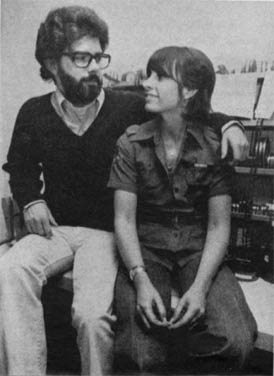What if George Lucas never met Marcia Lucas? Would the Star Wars saga have achieved its legendary status without her contributions? A bold statement reveals that Marcia Lucas played an indispensable role in shaping one of cinema's most iconic franchises. Her editing prowess transformed George Lucas' vision into a cinematic masterpiece, proving that behind every great director lies an equally talented editor.
George Lucas, born on May 14, 1944, in Modesto, California, revolutionized the film industry with his groundbreaking work. While much attention focuses on his directorial skills and creative genius, it is crucial to acknowledge the collaborative nature of filmmaking. Marcia Lucas, his then-wife and Academy Award-winning editor, was instrumental in refining the rough cuts of Star Wars into a cohesive narrative. Their partnership exemplifies how teamwork elevates artistry, turning ambitious projects into timeless classics. Without her meticulous approach to pacing, character development, and visual storytelling, the final product might not have resonated as profoundly with audiences worldwide.
| Personal Information | Details |
|---|---|
| Name | George Walton Lucas Jr. |
| Date of Birth | May 14, 1944 |
| Place of Birth | Modesto, California, USA |
| Spouse(s) | Marcia Lucas (1969–1983), Mellody Hobson (2013–present) |
| Children | Amanda Lucas, Katie Lucas, Jett Lucas, Everest Lucas |
| Net Worth (2024) | $5.7 billion (Source: Forbes) |
| Career Highlights | Director, Producer, Screenwriter; Creator of Star Wars and Indiana Jones franchises |
Lucas' career trajectory demonstrates remarkable resilience and innovation. Despite facing numerous challenges during the production of Star Wars, including budget constraints and technical limitations, he persevered. His ability to adapt and collaborate ensured the film's success. The decision to edit the movie himself initially led to inconsistencies and confusion within the narrative structure. However, Marcia Lucas intervened, bringing clarity and coherence to the storyline through strategic cuts and reordering scenes. This collaboration underscores the importance of trust and communication between directors and editors.
The financial implications of their partnership are staggering. When Disney acquired Lucasfilm in 2012 for approximately $4 billion, George Lucas's net worth skyrocketed by over $700 million. This acquisition solidified his legacy as one of the most influential figures in modern entertainment history. Moreover, his commitment to independent filmmaking set a precedent for future filmmakers aspiring to retain creative control while achieving commercial success.
Beyond monetary gains, Lucas has left an indelible mark on popular culture. The Star Wars universe continues to expand, captivating new generations of fans. Its influence extends beyond movies into literature, television series, video games, theme parks, and merchandise. Similarly, the Indiana Jones franchise remains beloved for its adventurous spirit and nostalgic appeal. Both properties exemplify Lucas' knack for creating enduring narratives rooted in mythology, science fiction, and action-adventure tropes.
Marcia Lucas's contribution deserves equal recognition. As an editor, she brought technical expertise and artistic insight to each project she worked on. Her ability to identify emotional beats and enhance storytelling through seamless transitions elevated the quality of films she collaborated on. Beyond Star Wars, she contributed significantly to other notable works such as American Graffiti and Apocalypse Now. These achievements highlight her versatility and dedication to her craft.
In addition to professional accomplishments, Lucas prioritizes philanthropy. Through organizations like the George Lucas Educational Foundation, he advocates for innovative educational practices aimed at empowering teachers and students alike. By investing in technology-enhanced learning environments, he seeks to bridge gaps in access to quality education globally. Such initiatives reflect his belief in using resources responsibly to effect positive change.
As we delve deeper into Lucas's impact, it becomes evident that his success stems from multiple factors. Firstly, his willingness to experiment with emerging technologies paved the way for advancements in special effects and digital animation. Secondly, his emphasis on world-building created immersive experiences that resonated deeply with audiences. Lastly, his partnerships with talented individuals like Marcia Lucas reinforced the value of collaboration in achieving greatness.
Despite controversies surrounding certain decisions regarding the Star Wars franchise, there is no denying Lucas's monumental contributions to cinema. His visionary approach continues to inspire filmmakers across various genres. Furthermore, his personal life reflects balance and growth, evidenced by his marriage to Mellody Hobson, a prominent businesswoman and advocate for diversity in finance. Together, they champion causes promoting equity and inclusion both professionally and personally.
Looking ahead, Lucas's legacy will undoubtedly endure. New installments in the Star Wars saga ensure ongoing engagement with fans worldwide. Meanwhile, his philanthropic efforts promise lasting benefits for communities seeking improved educational opportunities. Ultimately, George Lucas's story serves as a testament to perseverance, creativity, and collaboration—qualities essential for anyone striving to leave a meaningful mark on society.
In conclusion, while numbers such as a $5.7 billion net worth capture headlines, the true essence of George Lucas lies in his transformative influence on storytelling and education. His journey reminds us that behind every iconic creation stands a team of dedicated professionals working tirelessly to bring ideas to life. Recognizing these contributions fosters appreciation not only for individual brilliance but also for collective effort in achieving extraordinary results.

